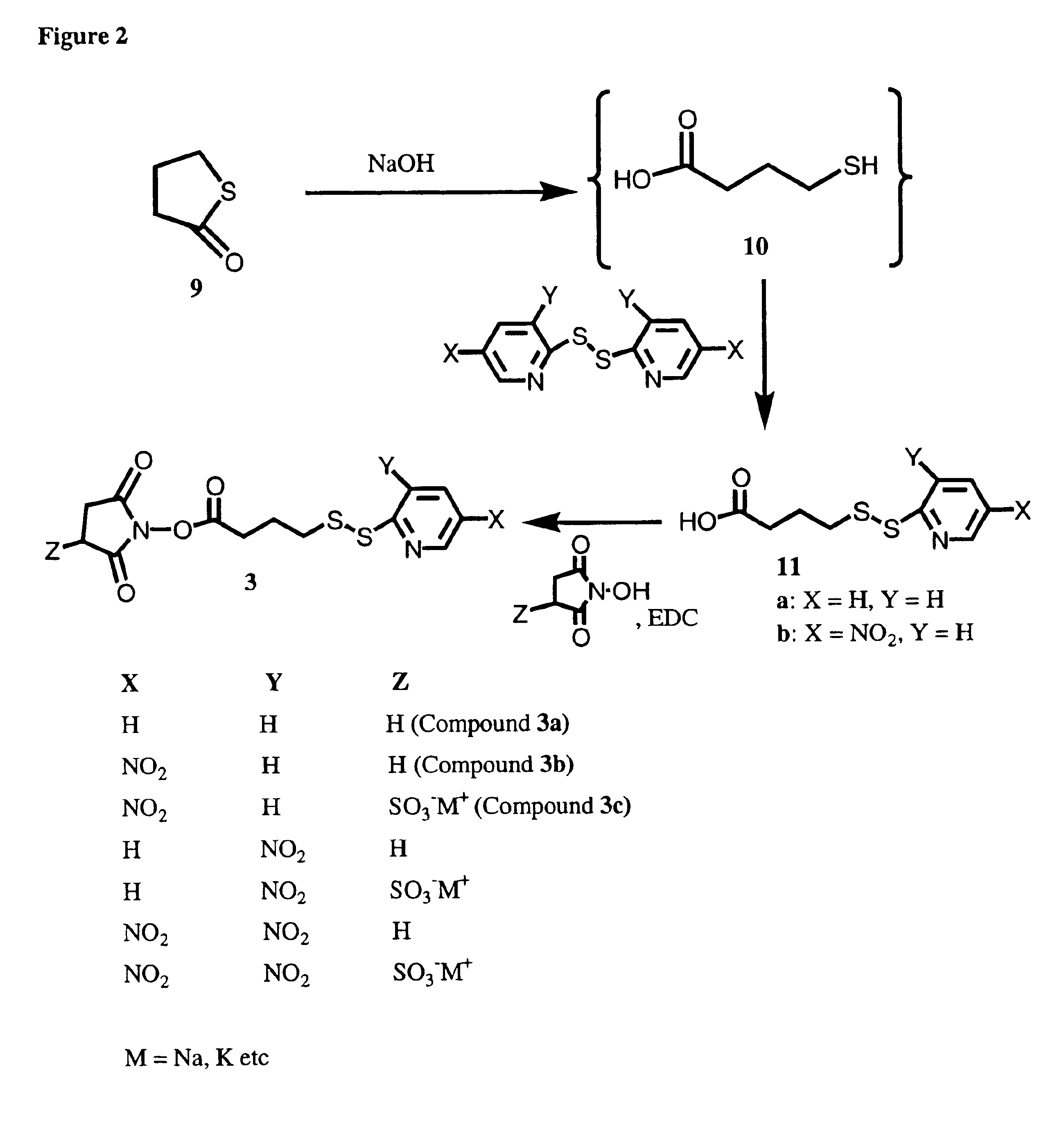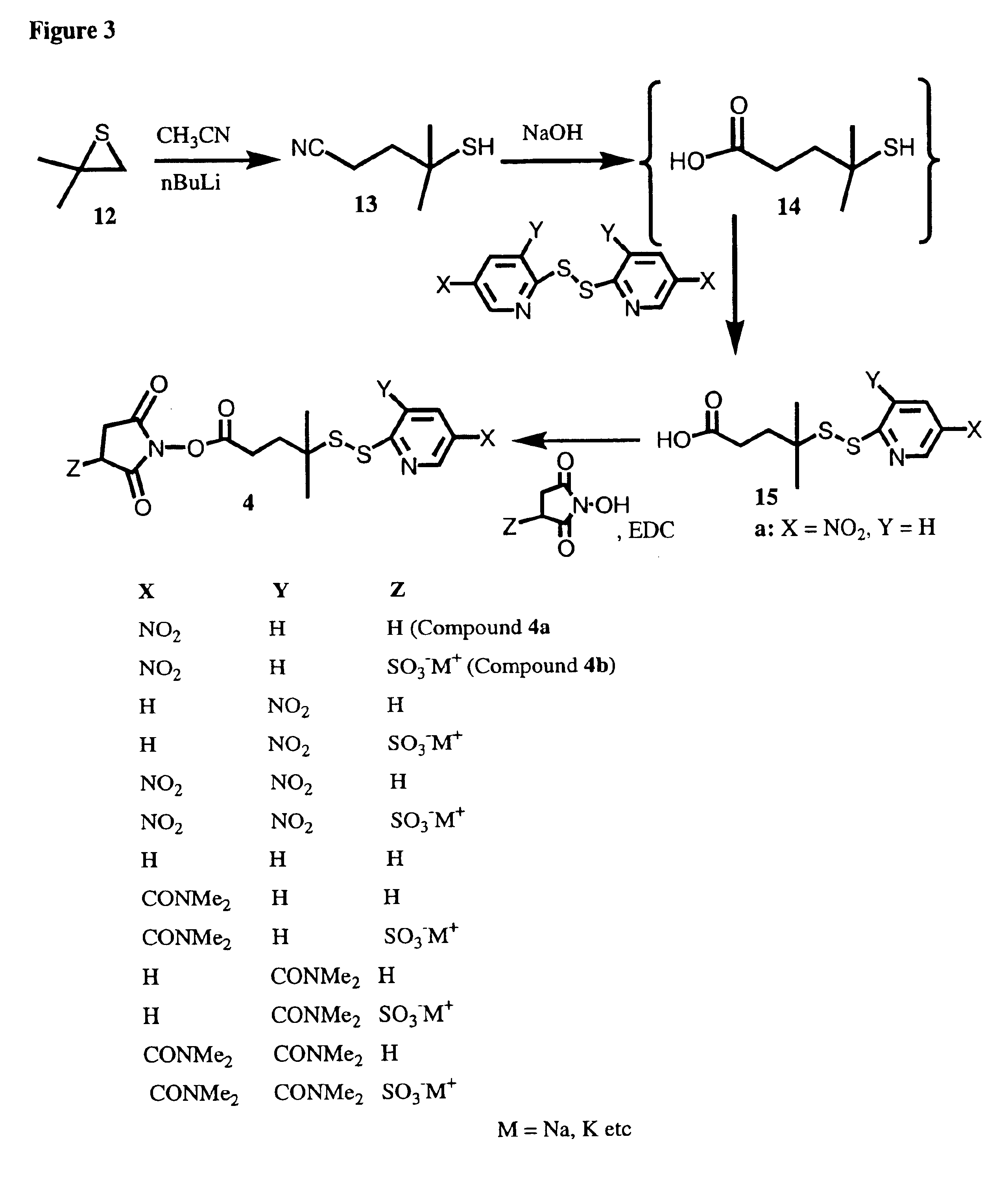Cross-linkers with high reactivity and solubility and their use in the preparation of conjugates for targeted delivery of small molecule drugs
a cross-linker and high reactivity technology, applied in the field of making conjugates of cell binding agents and small molecule drugs, can solve the problems of loss of reactivity, affecting the effect of drug delivery, and reducing the reaction rate of thiol-containing drugs and cell binding agents,
- Summary
- Abstract
- Description
- Claims
- Application Information
AI Technical Summary
Benefits of technology
Problems solved by technology
Method used
Image
Examples
example 1
Synthesis of 4-(5-Nitro-2-pyridyldithio)-pentanoic acid (NitroPPA, 8a)
[0167]A 100 L 2-necked flask was equipped with a stir bar, an addition funnel and a thermometer. The flask was charged with 1,3-dibromobutane (6) (5.2 g, 24 mmol) and dimethyl sulfoxide (30 mL). The addition funnel was charged with a solution of sodium cyanide (1.16 g, 24 mmol) in 5 mL of deionized water. The flask contents were vigorously stirred as the sodium cyanide solution was added dropwise at a rate which did not allow the reaction temperature to exceed 65° C. After addition was complete the reaction was stirred overnight. The mixture was extracted with deionized water (30 mL) and a 1:1 solution of ethyl acetate:hexanes (55 mL). The organic layer was retained and the aqueous layer was extracted a second time with 40 mL of 1:1 ethyl acetate:hexanes. The organic layers were combined and washed sequentially with deionized water (25 mL) and saturated aqueous sodium chloride (25 mL). The solvent was removed from...
example 2
N-Succinimidyl 4-(5-nitro-2-pyridyldithio)-pentanoate (1, SNPP)
[0169]A 50 mL flask was charged with 4-(5-nitro-2-pyridyldithio) pentanoic acid (8a, 0.51 g, 1.9 mmol), N-hydroxysuccinimide (0.24 g, 2.1 mmol) and a mixture of 1:1 tetrahydrofuran:methylene chloride (35 mL). The contents were stirred vigorously as a solution of 0.41 g of 1-(3-dimethylaminopropyl)-3-ethylcarbodiimide hydrochloride (0.41 g, 2.1 mmol) in tetrahydrofuran (5 mL) was added. The reaction mixture was stirred at room temperature for 2 h. The solvent was then removed by rotary evaporation under vacuum. The residue was dissolved in a minimum volume of methylene chloride and purified by silica chromatography using a mobile phase of 1:1.5 (v / v) tetrahydrofurane:hexane containing 0.5% acetic acid. Fractions containing pure product were combined and solvent was removed by rotary evaporation under vacuum to give the desired compound 1. 1H NMR (CDCl3) 9.26 (d, 1H, J=2.5 Hz), 8.38 (dd, 1H, J=2.5 & 8.9 Hz), 7.84 (d, 1H, J...
example 3
N-Sulfosuccinimidyl 4-(5-nitro-2-pyridyldithio)-pentanoate (2, SSNPP)
[0170]A 10 mL flask was charged with 4-(5-nitro-2-pyridyldithio) pentanoic acid (8a, 0.11 g, 0.41 mmol), N-hydroxysulfosuccinimide (0.83 g, 0.38 mmol), dicyclohexylcarbodiimide (0.080 g, 0.39 mmol), and dimethylacetamide (1.5 mL). The reaction mixture was stirred overnight. The flask was then cooled in an ice bath for 2 hours, and the precipitated dicyclohexylurea was filtered off. Ethyl acetate (45 mL) was added to the filtrate, the resulting suspension was stirred for 2 min, and the precipitate was collected by filtration. The precipitate was dried overnight under vacuum at room temperature, which yielded 0.092 g of 2 (51% yield). MS 463.9 (M−−Na+). 1H NMR (6:1 CDCl3:DMSO-d6) 8.68 (d,1H, J=2.5 Hz), 7.93 (dd, 1H J=2.5, 8.9 Hz), 7.42 (d, 1H, J=8.9 Hz), 3.51 (dd, 1H, J=8.8,2.8), 2.6 (m, 5H), 1.46 (m, 2H), 0.82 (d, 3H, J=6.7 Hz).
PUM
| Property | Measurement | Unit |
|---|---|---|
| Molar density | aaaaa | aaaaa |
| Molar density | aaaaa | aaaaa |
| Molar density | aaaaa | aaaaa |
Abstract
Description
Claims
Application Information
 Login to View More
Login to View More - R&D
- Intellectual Property
- Life Sciences
- Materials
- Tech Scout
- Unparalleled Data Quality
- Higher Quality Content
- 60% Fewer Hallucinations
Browse by: Latest US Patents, China's latest patents, Technical Efficacy Thesaurus, Application Domain, Technology Topic, Popular Technical Reports.
© 2025 PatSnap. All rights reserved.Legal|Privacy policy|Modern Slavery Act Transparency Statement|Sitemap|About US| Contact US: help@patsnap.com



